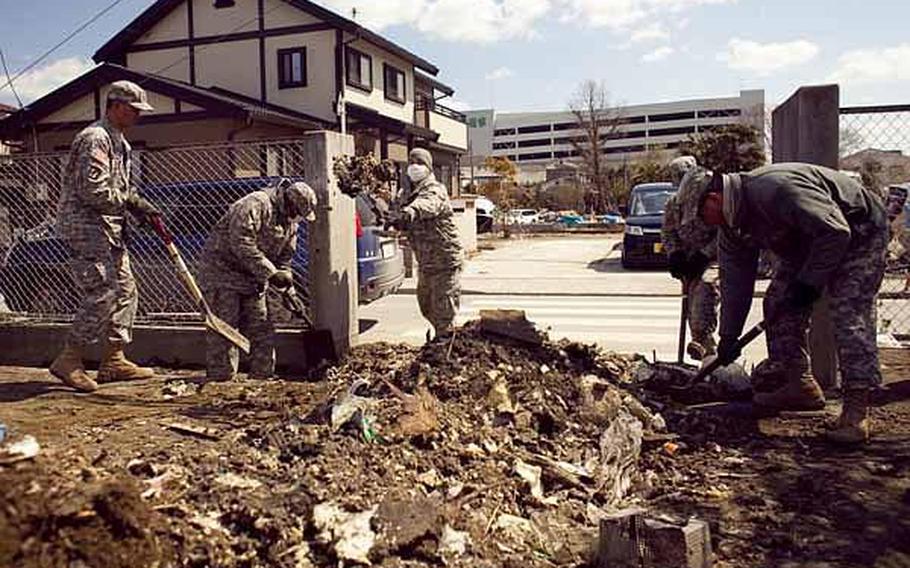
Soldiers from Logistics Task Force 35, shovel debris from a school yard in Ishinomaki, Japan, following the March 11 earthquake and tsunami. Military health officials say that air, water and soil samples tested in the region in April did not contain dangerous levels of toxins or radiation. (Nathan Bailey/Stars and Stripes)
CAMP FOSTER, Okinawa — Dangerously high radiation could prompt the Japanese government to ban residents from returning to towns around the damaged Fukushima Dai-ichi nuclear power plant for several decades, the Yomiuri newspaper reported Monday.
Radiation at three towns within the restricted 12-mile radius of the plant measured from about 6 times to 25 times the level considered safe by the Japanese government, according to a report released Friday by the country’s Ministry of Education, Culture, Sports, Science and Technology.
The towns in the restricted zone are still far from U.S. military bases in the region where residents have feared exposure and are deep within a much wider 50-mile safety radius around Fukushima set by the State Department.
However, the report is the latest indication that a near nuclear meltdown at Fukushima caused by a massive earthquake and deadly tsunamis in March has spread worrisome levels of radiation in the region and will likely affect Japan for years to come.
Since Japan evacuated the area around the plant, small levels of radiation have been discovered in children and produce from the area and in rice fields as far as Tokyo, which is about 150 miles south.
The highest radiation reported Friday was in a section of Okuma where levels reached 500 millisieverts, which is far higher than the 20 millisieverts considered safe by Japan, according to the ministry report.
The towns of Futaba and Namie reported levels between 127 and 224 millisieverts.
Japan Prime Minister Naoto Kan is expected to meet with those local government officials to notify them that the government will not allow residents to return, Yomuiri reported.
The evacuation of the 12-mile restricted zone pushed about 78,000 residents from the area and left 27,000 homes vacant, according to the Japanese government.
It is still unclear whether those who live and work at military facilities have been exposed to radiation from Fukushima, though some servicemembers and equipment involved in disaster relief efforts in the Tohoku region did come in contact with some of the radioactive material spewing from heavily damaged reactors in the weeks after the earthquake.
U.S. Pacific Command said last month the military will calculate the levels of exposure for the 61,000 personnel at the bases in Japan, though it believes any exposure has been minimal.
Exposure levels will be determined by using models created for the 20,000 servicemembers who participated in Operation Tomodachi and for atomic testing in the 1950s and 1960s, according to the Armed Forces Radiobiology Research Institute.
Last week, the U.S. Army announced it has set up new high-powered radiation detectors at Camp Zama near Tokyo that will allow it to do detailed analysis of any threat without having to send samples to the United States. The service said that the new sensors are only a precaution.
Nearly 10,000 military dependents from Yokota Air Base, Yokuska Naval Base, Naval Air Facilitiy Atsugi, Camp Zama and Misawa Air base left the country and took shelter in the United States as the disaster unfolded in March and fears of a nuclear meltdown spread.
Japan toiled for months dousing overheated fuel rods to avoid a nuclear meltdown and has now brought the ongoing nuclear reaction mostly under control.
The power company that owns Fukushima has said it hopes to pump out about 120,000 tons of radioactive water and bring the plant to a cold shutdown by this winter.
Stars and Stripes reporter Chiyomi Sumida contributed to this story.